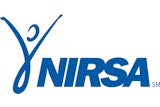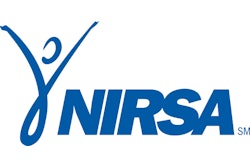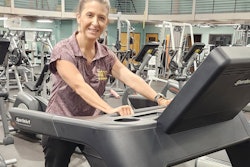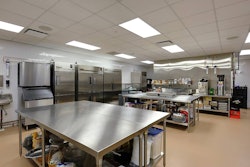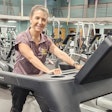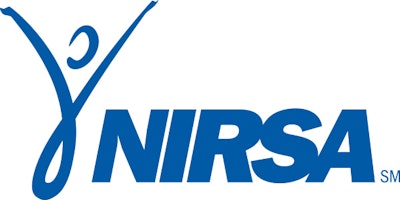
In October, the University of Kansas became the first NIRSA member institution to complete an external campus recreation department review under the Program Review Collaborative (PRC) — a partnership NIRSA joined in February 2024 that leverages a broad network of experienced professionals from several national student affairs associations.
The PRC now brings together the expertise and resources of NIRSA along with those of the Association of Colleges and University Housing Officers - International (ACUHO-I), the Association of College Unions International (ACUI) and Student Affairs Administrators in Higher Education (NASPA) to present campus programs and departments with insights on staffing, administrative processes, programmatic offerings, student engagement mechanisms and collaborative ventures within the broader campus community. Reviewers are identified and vetted through PRC member associations.
“It is natural to have apprehension going into an outside review of your program,” says KU director of Recreation Services Jason Krone, who admits he was skeptical. “But I was able to quickly get over it, because if you’ve got nothing to hide, then a review is great. It can help confirm things that you’re doing, things that you don’t have and things that you should have — along with offering some suggestions for improvement. It didn’t take me long to embrace the process.”
That process involves a detailed review of materials, in-depth interviews and meaningful discussions with campus recreation stakeholders, according to NASPA director of external program reviews Melissa Flowers, who was involved in the KU review. The campus recreation department at Grand Valley State University in Allendale, Mich., is the second NIRSA member institution to participate in a review, which was underway at the time of this writing.
PRC reviews differ from those by private consultants. Not only are the reviews performed by peers in higher education, but they are also tailored to generate the most impact.
“The PRC’s main advantage is the expertise and insights brought by each review team composed of career professionals with extensive industry experience,” Flowers says. “PRC reviews also draw on the frameworks and rich knowledge base of PRC partner organizations, including NIRSA. They are campus-specific and adaptable to each institution’s unique needs and goals. By participating in a PRC review, campus recreation professionals gain an objective perspective that can uncover areas for improvement or excellence that might be overlooked internally, or help validate strengths and opportunities that have already been identified.”
That was certainly the case for Krone and his KU team members, who are now working to put the department’s review results into action. “A lot of the recommendations talk about creating strategic plans and then combining those strategic plans into a holistic, department-wide plan to move forward,” he says.
Validation and perspective
KU Student Affairs has used the PRC process with beneficial outcomes. After NIRSA joined the collaborative, it made sense for KU Recreation Services to participate. “We were thrilled to be the first campus recreation program to participate with NIRSA as a part of the collaborative,” says Krone.
That review covered all operational areas except outdoor facilities. The process began with Krone and his staff gathering a substantial amount of virtual files containing “anything and everything,” he says — from policies and protocols to participation numbers.
Next, the two-member PRC review team (which included Flowers and Wendy Windsor, past president of NIRSA and director of campus recreation at Tulane University) visited the campus to tour facilities and meet with numerous stakeholder groups that included full-time staff members, student staff members and representatives of other campus departments such as Wellness and Student Affairs.
“It was two days of meetings, meetings, meetings,” Krone says. “But what I liked about it is that everything took place without leadership in the meetings. So, I set up all the meetings, but I wasn’t in them. My supervisor wasn’t in them. Just those specific employee groups, peer groups and the review team were in them.”
Flowers applied the PRC’s review process to the proceedings, while Windsor brought the campus recreation expertise, Krone says. After a virtual follow-up meeting with some department representatives, the PRC staff delivered a 40-page report that contained an introduction to the methodology, findings, analyses, a summary of recommendations and appendices with supporting documents.  Photo courtesy of the University of Kansas
Photo courtesy of the University of Kansas
“It contained things we already knew, and also suggestions,” Krone says. “We know that our facility is too small and too crowded. We know that our equipment layout is not ideal. We know that we need more full-time staff and a larger budget. But other things came out, too. We found that we need to continue to work on internal communication with our staff. Our mission and branding also need to be expanded.”
And that, according to Flowers, is an example of the vital feedback a PRC review can provide a campus recreation department.
“KU found great value in the validation of their existing efforts, along with the critical insights gained from focus group analysis,” she says. “The feedback affirmed what they’re doing well while providing a constructive perspective on areas they could enhance.”
Patient implementation
“Some people may look at a report like this, with all kinds of suggestions, and think they need to immediately jump into it,” Krone says. “But I’m taking a little bit more of a patient approach, knowing there are a couple of other things that have to fall into place alongside this.”
One of those things is the pending approval of a master plan for KU Recreation Services, which could result in a spring referendum question about expanding the 150,000-square-foot Ambler Student Recreation Fitness Center and thus impact some PRC-related strategic planning. Krone notes that a study conducted in 2017 revealed that the facility should be at least 100,000 square feet larger, based on KU’s student enrollment. The PRC review might serve as a catalyst for change, as an objective third-party document emphasizing campus recreation department needs could positively influence university administration.
Krone hopes to soon have a better idea of when some of the PRC review’s recommendations can be implemented, with a target of fall 2025.
“I think it was incredibly valuable, but make sure you go in with an open mind on how you can get better as a department,” he says, reflecting on the PRC review process. “If you’re worried about what the review might find, that’s going to be challenging, right? But there’s no such thing as staying the same; you’re either getting better or you’re getting worse. And so for me, this review has given our department plenty of suggestions for how to get better.”














